What Netflix’s Recommendation Algorithm Can Teach Us About Personalization
January 31, 2025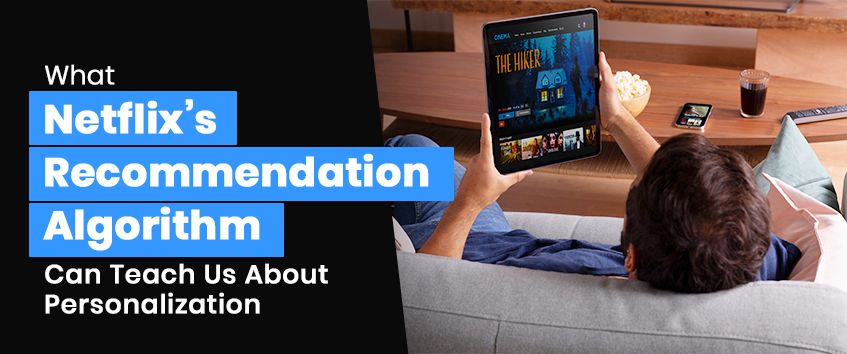
In today’s digital-first world, personalization has emerged as a key differentiator for businesses across industries. By tailoring products, services, and experiences to individual preferences, companies can create deeper connections with their audiences. Among the pioneers of effective personalization, Netflix stands out as a shining example. The streaming giant’s recommendation algorithm is widely regarded as the gold standard, influencing user behaviour, boosting engagement, and setting benchmarks for the industry.
Netflix has redefined how businesses approach user experiences by making personalization the cornerstone of its strategy. Its ability to understand individual preferences and predict what users want—often before they know it themselves—has propelled it to become a global leader in streaming entertainment. With over 238 million subscribers worldwide (as of 2024), Netflix exemplifies how data-driven personalization can drive loyalty and long-term success.
This blog explores the inner workings of Netflix’s recommendation engine, highlighting the innovative techniques and technologies that make it so effective. It also uncovers valuable lessons that businesses across industries can learn from Netflix’s approach to personalization. From content marketing to e-commerce, the strategies discussed here can help organizations elevate their personalization efforts and create meaningful connections with their audiences.
Whether you’re a digital marketer, a content creator, or a business leader, understanding the principles behind Netflix’s personalization success can inspire transformative ideas for your own strategies. For a digital marketing agency in Kochi, adopting similar personalization techniques can significantly enhance campaign effectiveness and client engagement. By delving into the methods and insights shared here, you’ll gain a comprehensive understanding of how to leverage personalization as a tool for growth and innovation in your industry.
The Power of Netflix’s Personalization Engine
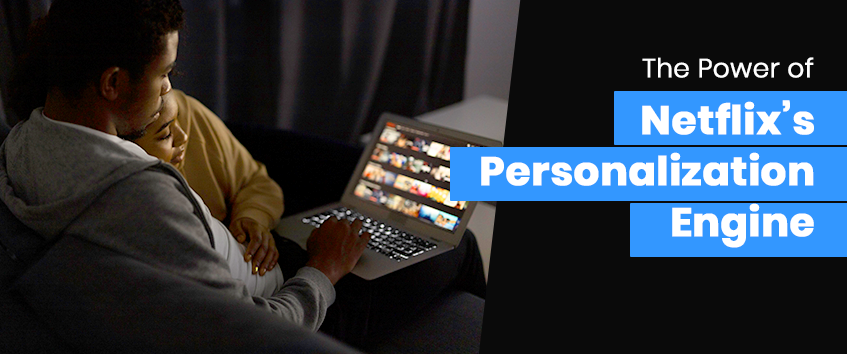
Netflix’s meteoric rise can largely be attributed to its exceptional ability to offer users exactly what they want—sometimes even before they know they want it. With millions of subscribers worldwide, Netflix’s success demonstrates how effective personalization can drive user retention, satisfaction, and loyalty. By leveraging cutting-edge technology and data-driven strategies, Netflix has set the gold standard for personalization in the entertainment industry.
How Netflix’s Algorithm Works
At the core of Netflix’s personalization strategy lies a sophisticated recommendation algorithm powered by advanced machine learning models and vast amounts of data. Here’s a closer look at how it works:
- Data Collection Netflix collects an enormous amount of data from its users to better understand their preferences and behaviours. Key data points include:
- Viewing History: Every movie or TV show watched contributes to refining user profiles.
- Search Queries: The searches users perform help indicate interests and intentions.
- Ratings: User feedback through thumbs up or down provides direct input on preferences.
- Time Spent Watching: The amount of time spent on specific content helps determine engagement levels.
- Device and Usage Patterns: Netflix monitors the type of device used and the time of day content is consumed to tailor recommendations accordingly.
By gathering such comprehensive data, Netflix creates a detailed and dynamic profile for each user, enabling highly personalized recommendations.
- Content Categorization One of Netflix’s most innovative techniques is its classification of content into thousands of micro-genres, often referred to as “alt-genres.” These hyper-specific categories—such as “Emotional Independent Crime Movies” or “Suspenseful Sci-Fi Thrillers”—allow the platform to match users with content that aligns closely with their tastes. This granular approach ensures that even niche preferences are catered to, enhancing user satisfaction.
- Machine Learning Models Netflix’s algorithm utilizes advanced machine learning models to analyse data and predict user preferences. Two key techniques include:
- Collaborative Filtering: This method examines patterns in user behaviour to identify similarities among viewers. For example, if two users have a similar viewing history, Netflix might recommend shows or movies one user has watched to the other.
- Deep Learning: By analysing metadata, video tags, and even visual elements like thumbnails, deep learning models identify nuanced patterns that influence user preferences. These insights are used to refine recommendations further.
- A/B Testing Optimization is a continuous process at Netflix. The platform runs countless A/B tests to experiment with different elements of the user interface. These tests evaluate factors such as:
- Thumbnail designs
- Title placements
- Ordering of recommended content
Every detail is rigorously tested to determine what resonates best with viewers, ensuring the user experience is constantly improved.
- Continuous Learning Netflix’s algorithm is designed to adapt and evolve with user interactions. As preferences and viewing habits change, the algorithm recalibrates itself to provide the most relevant recommendations. This dynamic approach ensures that the content offered remains engaging and timely for every user.
By combining these strategies, Netflix has created a recommendation system that not only enhances user experiences but also sets a benchmark for personalization across industries. Its success underscores the importance of leveraging data, testing, and innovation to meet and exceed user expectations.
Lessons for Personalization from Netflix
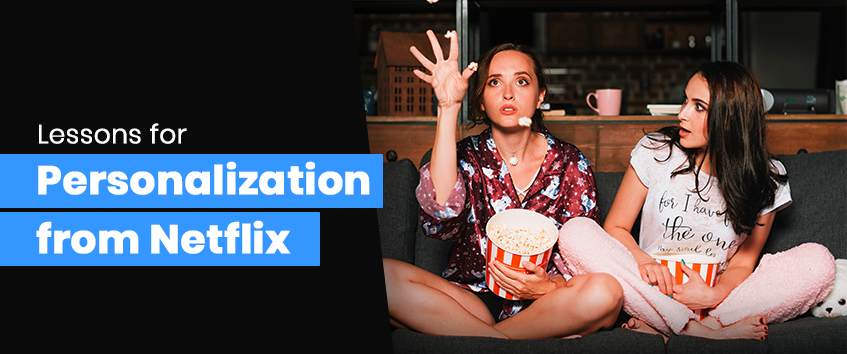
Netflix’s personalization strategy offers a treasure trove of insights that businesses across industries can adopt. Here are some key takeaways from their approach to creating meaningful and engaging user experiences:
1. Know Your Audience Better Than They Know Themselves
Netflix excels in anticipating user needs by deeply understanding individual preferences. By analysing user behaviour at a granular level, Netflix ensures its recommendations are hyper-relevant, creating a sense of personal connection for each viewer.
How This Applies to Digital Marketing:
- Create Detailed Buyer Personas: Use customer data to build comprehensive profiles that capture demographics, interests, and behaviours.
- Analyse User Interactions: Study how users navigate your website or app. Pay attention to click patterns, time spent on pages, and content consumption to understand preferences and intent.
- Use Behavioural Triggers: Implement tools to track and respond to customer actions, such as cart abandonment emails or personalized product recommendations.
2. Hyper-Segmentation is Key
Netflix’s use of micro-genres demonstrates the importance of niche segmentation. By breaking down content into highly specific categories, Netflix ensures users find exactly what resonates with them, no matter how unique their preferences.
How This Applies to Digital Marketing:
- Segment Your Audience: Go beyond basic demographics and segment your audience based on behaviours, purchasing patterns, and interests.
- Targeted Ad Campaigns: Design ad campaigns and messaging tailored to each segment’s unique needs and preferences.
- Personalized Content: Develop content for specific audience clusters to increase relevance and engagement.
3. Leverage Data Analytics
Netflix’s success is rooted in its data-driven approach. Every user action serves as a data point, feeding into their recommendation engine to refine and optimize personalization.
How This Applies to Digital Marketing:
- Invest in Analytics Tools: Use advanced tools to collect and analyse customer data.
- Track Key Metrics: Focus on click-through rates, bounce rates, and conversion paths to identify what drives user engagement.
- Predictive Analytics: Leverage AI and machine learning tools to predict future customer behaviours and preferences.
4. Optimize Visual Presentation
Netflix customizes thumbnails to align with user preferences, highlighting the importance of visual elements in driving engagement. A compelling visual can significantly impact a user’s decision to engage with content.
How This Applies to Digital Marketing:
- Test Visual Elements: Experiment with different images, videos, and layouts in your ads and content to determine what resonates most.
- Dynamic Visuals: Use tools to adapt visuals in real-time based on user behaviour or demographics.
- Consistent Branding: Ensure visuals align with your brand identity while catering to individual preferences.
5. Focus on Continuous Improvement
Netflix’s algorithm evolves constantly, adapting to changes in user behaviour and preferences. This commitment to iteration ensures that recommendations remain relevant and effective.
How This Applies to Digital Marketing:
- Monitor Campaign Performance: Regularly review the success of your personalization strategies and campaigns.
- Run A/B Tests: Test different versions of ads, emails, or landing pages to determine what performs best.
- Iterative Refinement: Use data from tests and campaigns to refine strategies continually, ensuring sustained improvement and engagement.
By adopting these lessons from Netflix, businesses can create personalized experiences that resonate deeply with their audiences, fostering loyalty and long-term success.
The Role of AI and Machine Learning in Personalization
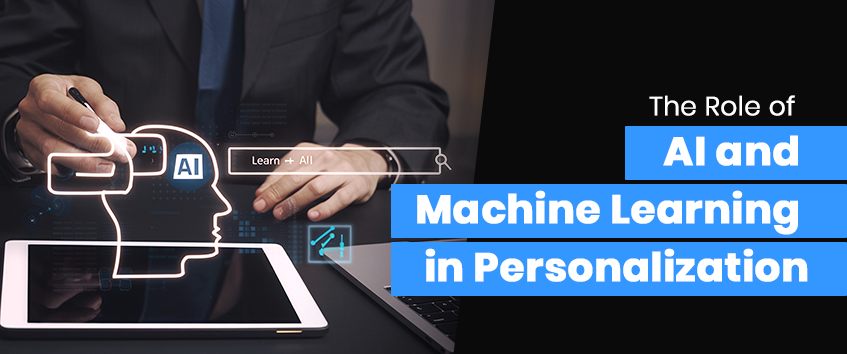
Netflix’s personalization strategy is a shining example of how artificial intelligence (AI) and machine learning (ML) can transform user experiences. By leveraging these advanced technologies, Netflix can process vast amounts of data and generate actionable insights that enhance engagement and satisfaction. Let’s explore how AI and ML are pivotal to Netflix’s approach to personalization and the broader implications for businesses.
Predictive Analytics
One of the core strengths of AI is its ability to predict user behaviour based on past interactions. Netflix’s AI models analyse a user’s viewing history, preferences, and engagement patterns to anticipate what they might want to watch next. This predictive capability ensures recommendations are proactive rather than reactive, creating a seamless experience for the user.
For example, if a user has watched multiple romantic comedies, the algorithm might suggest new releases or hidden gems in the same genre. This not only saves the user time but also enhances their satisfaction by offering precisely what they’re likely to enjoy.
Applications for Businesses:
- Use predictive analytics to forecast customer needs and trends.
- Implement AI-driven tools to recommend products or services based on browsing and purchase history.
Content Personalization
Machine learning algorithms play a critical role in analysing content metadata to understand its characteristics. Netflix’s algorithm evaluates factors such as genre, actors, directors, themes, and even user reviews. By understanding these nuances, the platform can make highly specific and accurate recommendations that align with a user’s tastes.
For instance, two users might both enjoy action movies, but one prefers sci-fi thrillers while the other gravitates toward historical dramas. Netflix’s ability to differentiate and recommend accordingly sets it apart from competitors.
Applications for Businesses:
- Analyse product or service attributes to match them with customer preferences.
- Create detailed tagging systems to facilitate more accurate recommendations.
Real-Time Personalization
AI enables Netflix to deliver real-time personalization. As users interact with the platform, the algorithm adapts instantly to reflect their most recent activity. For example, if a user starts watching documentaries, their recommendations will shift to highlight similar content, even if their past preferences leaned toward sitcoms.
This dynamic personalization keeps the user experience fresh and relevant, fostering a sense of connection and understanding.
Applications for Businesses:
- Implement AI systems that adjust recommendations in real-time based on user activity.
- Use dynamic website and app elements to reflect current customer interests.
Implications for Businesses
The role of AI and ML in personalization extends far beyond Netflix. Businesses across industries can harness these technologies to enhance customer experiences and drive growth. Here’s how:
- Invest in AI-Powered Tools: Modern AI platforms provide robust solutions for data analysis and personalization, making it easier for businesses to implement advanced techniques without developing them from scratch.
- Leverage Predictive Analytics: Use predictive models to anticipate customer needs, recommend products, and optimize inventory.
- Enhance Customer Journeys: AI can map out personalized customer journeys, identifying the touchpoints that matter most to each user.
- Improve Engagement: Real-time personalization ensures customers feel understood, increasing satisfaction and loyalty.
By adopting AI and ML, businesses can emulate Netflix’s success in creating highly personalized experiences. These technologies offer unparalleled opportunities to connect with customers on a deeper level, paving the way for long-term engagement and growth.
Challenges in Implementing Personalization
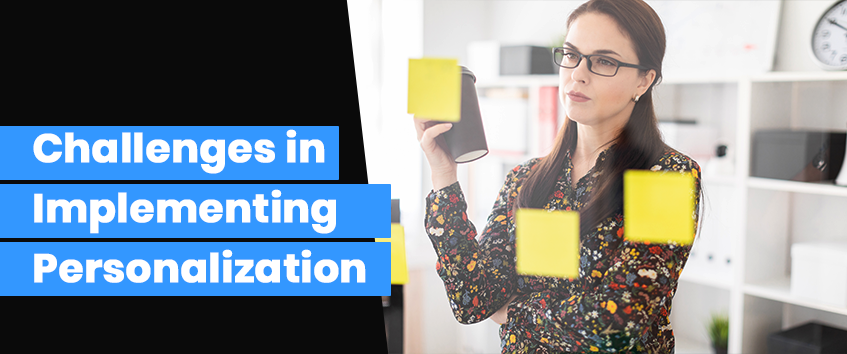
While personalization offers immense advantages, it is not without its challenges. Netflix’s journey to becoming the gold standard in personalized experiences highlights several obstacles businesses may encounter when implementing similar strategies. Understanding these challenges and how to address them is key to successful personalization initiatives.
1. Data Privacy Concerns
Personalization hinges on collecting and analysing user data, which inevitably raises privacy concerns. Users are increasingly aware of how their data is being used, and many are wary of sharing personal information. For Netflix, mitigating these concerns involves anonymizing user data, adhering to strict privacy policies, and ensuring transparency.
Challenges:
- Ensuring compliance with data protection regulations such as the General Data Protection Regulation (GDPR) and the California Consumer Privacy Act (CCPA).
- Balancing the need for data collection with user expectations of privacy.
- Addressing fears of data misuse or breaches.
Solutions for Businesses:
- Be Transparent: Clearly communicate how customer data is collected, stored, and used. Transparency fosters trust.
- Ensure Compliance: Adhere to relevant regulations like GDPR and CCPA, demonstrating your commitment to user privacy.
- Use Anonymized Data: Whenever possible, anonymize data to protect individual identities while still gaining valuable insights.
2. Resource Intensiveness
Building a robust personalization engine, like Netflix’s, requires significant investments in data infrastructure, advanced technology, and skilled personnel. For many businesses, these resource demands can be daunting.
Challenges:
- High upfront costs for AI and machine learning tools.
- Ongoing investment in data storage and processing capabilities.
- The need for skilled professionals to develop, maintain, and optimize personalization systems.
Solutions for Businesses:
- Start Small: Begin with basic personalization techniques, such as segmented email campaigns or product recommendations, and scale up as your resources grow.
- Leverage Third-Party Tools: Use existing platforms and tools designed for personalization, which are often more cost-effective than building systems from scratch.
- Outsource Expertise: Partner with agencies or consultants specializing in personalization to reduce the burden on internal teams.
3. Balancing Automation and Human Touch
While automation through AI and machine learning can significantly enhance efficiency and scale, over-reliance on algorithms risks making user experiences feel impersonal. Customers often value a human touch, especially in industries like healthcare, hospitality, and customer service.
Challenges:
- Avoiding a one-size-fits-all approach that alienates users.
- Ensuring automated recommendations align with users’ emotional and contextual needs.
- Maintaining a sense of personalization without losing the warmth of human interaction.
Solutions for Businesses:
- Blend AI with Human Insights: Combine automated personalization with human-driven strategies. For instance, use AI to analyse data and human expertise to craft empathetic messages or solutions.
- Empower Customer Interaction: Offer users the option to customize their experience manually, giving them greater control.
- Monitor Feedback: Regularly gather and analyse user feedback to ensure the personalization strategy resonates with the audience.
Applying Netflix’s Lessons in Digital Marketing
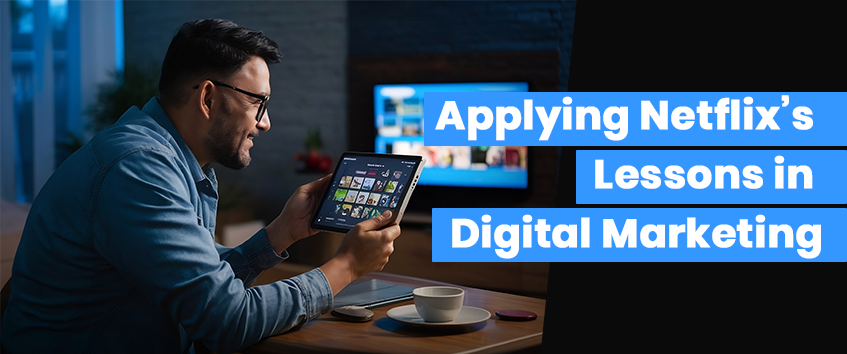
Netflix’s success with personalization offers a blueprint for digital marketing agencies and businesses aiming to enhance customer experiences. By adopting Netflix’s strategies, marketers can create tailored, engaging interactions that resonate with their audiences. Here’s how to incorporate these lessons into digital marketing practices:
Content Marketing
Personalized content marketing can significantly increase user engagement and drive conversions. Netflix’s ability to recommend hyper-specific genres and content highlights the importance of creating micro-segmented content for distinct audience groups.
Applications:
- Create Micro-Segmented Content: Develop tailored blog posts, videos, and infographics that cater to specific audience interests and behaviours. For example, a fitness brand could create separate content for beginners, advanced athletes, and individuals interested in specific disciplines like yoga or weightlifting.
- Use Personalization Tools: Leverage AI-powered content recommendation engines to suggest relevant resources based on user preferences. For instance, a blog on sustainable living could recommend articles about eco-friendly products or energy-saving tips based on user browsing history.
- Dynamic Updates: Continuously refine content recommendations based on user feedback and analytics.
Email Marketing
Netflix’s personalized recommendations extend to its email communication, demonstrating how email marketing can benefit from individualization.
Applications:
- Personalize Subject Lines: Use customer data to craft subject lines that capture attention. A subject like “Your next favourite thriller awaits” is more engaging than a generic email.
- Tailor Email Content: Segment email lists based on user behaviour and demographics. For instance, an e-commerce brand could send product recommendations based on past purchases or browsing habits.
- Dynamic Email Visuals: Incorporate dynamic content in emails to adapt visuals, offers, and recommendations in real-time. For example, a travel agency could showcase destination deals tailored to the recipient’s preferred travel type, such as adventure or luxury.
Social Media Marketing
Netflix’s use of audience insights to drive content recommendations can also transform social media marketing. Personalized strategies foster stronger connections and higher engagement rates.
Applications:
- Create Hyper-Targeted Campaigns: Use social media platforms’ advanced targeting options to design campaigns that resonate with specific audience segments. For instance, a fashion brand could target ads for formal wear to professionals and casual outfits to students.
- Retargeting Campaigns: Re-engage users with personalized offers based on their past interactions. For example, a user who viewed a specific product on your website could be retargeted with a social media ad featuring the same product.
- Analyse Engagement Metrics: Regularly analyse likes, shares, and comments to refine audience insights and improve targeting.
E-Commerce
Netflix’s recommendation engine is a cornerstone of its personalization strategy, and e-commerce businesses can adopt similar tactics to boost sales.
Applications:
- Implement Recommendation Engines: Use AI tools to suggest products based on user browsing and purchase history. For example, a beauty retailer could recommend complementary products, such as a moisturizer to pair with a cleanser.
- AI-Driven Chatbots: Deploy AI-powered chatbots to provide personalized assistance, answer queries, and recommend products in real-time.
- Dynamic Pricing and Offers: Customize discounts and offers for users based on their behaviour and loyalty levels, similar to how Netflix offers free trials or promotional subscriptions to attract new users.
The Future of Personalization
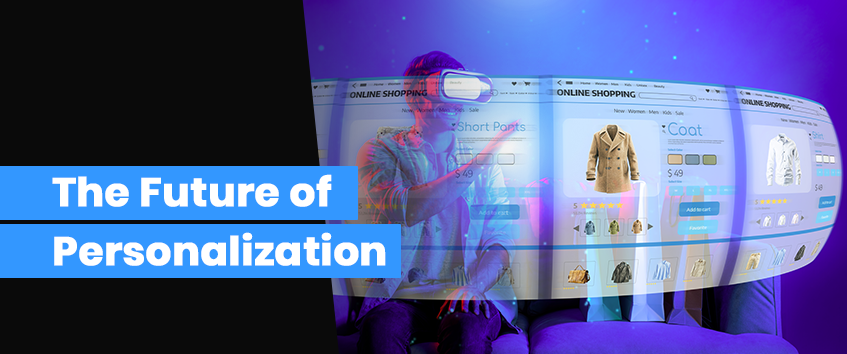
Netflix’s continuous innovation in personalization provides valuable insights into the future of tailored experiences. Emerging trends are reshaping how businesses approach personalization, with an increasing emphasis on user context, technology integration, and ethical considerations.
Context-Aware Personalization
The next phase of personalization will extend beyond static user preferences to include real-time contextual factors. Elements such as a user’s location, time of day, weather conditions, and even mood will play a critical role in shaping recommendations. For instance, Netflix could suggest uplifting content on a rainy afternoon or offer lighter genres late at night.
Implications for Businesses:
- Leverage contextual data to deliver dynamic experiences.
- Use geolocation, time-based triggers, and environmental data to enhance relevance.
Voice and Visual Search
As smart assistants and visual search tools become mainstream, personalization strategies must adapt to these evolving interaction methods. Voice commands and image-based searches are creating opportunities for businesses to offer more intuitive and personalized user experiences.
Implications for Businesses:
- Optimize content for voice and visual search technologies.
- Use AI to analyse and respond to non-textual user inputs, such as spoken queries or uploaded images.
Ethical Personalization
With growing awareness of data privacy, businesses must find ways to balance personalization with ethical practices. Transparency in data collection, user consent, and adherence to privacy regulations like GDPR will become non-negotiable.
Implications for Businesses:
- Be transparent about data usage and prioritize user consent.
- Focus on anonymized data and secure storage practices.
Netflix’s recommendation algorithm is a masterclass in personalization, demonstrating the power of data-driven strategies to create exceptional user experiences. By understanding and implementing the lessons from Netflix, businesses across industries can elevate their personalization efforts, build stronger customer relationships, and drive sustainable growth. Online marketing agencies can draw valuable insights from Netflix’s approach to enhance campaign targeting and deliver more relevant content to audiences. The future of personalization is bright, but it’s also complex. As technology evolves, so too will consumer expectations. Businesses that invest in advanced personalization techniques today will be better equipped to meet the demands of tomorrow. In the world of digital marketing, where relevance is everything, Netflix’s approach serves as a reminder that personalization isn’t just a strategy—it’s an imperative.
